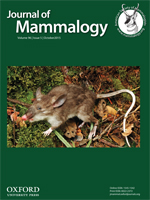Capturing and collaring mammalian newborns is a valued technique in studies focused on survival, cause-specific mortality, maternal investment, and other aspects of animal behavior and ecology. Abandonment of ungulate neonates has been highly variable and often may be underestimated due to limited understanding of this maternal behavior. In a study of survival and cause-specific mortality of GPS-collared moose (Alces americanus) calves in a declining population in northeastern Minnesota, 9 of 49 (18.4%) neonates (25 females and 24 males) were abandoned postcapture (8–17 May 2013) by 7 of 31 (22.6%) mothers. During the 1–6-h-interval postcapture, nonabandoning and abandoning mothers were similar distances from their calves. However, for nonabandoning mothers, from 13 to 48 h postcapture mean 6-h-interval distances to their calves steadily approached 0 m, whereas for abandoning mothers, mean distances to their calves continued to increase from 7 to 48 h. Five of the 7 abandoning mothers stayed with their calves immediately after capture for up to 11 h before leaving. Additionally, 5 abandoning mothers and 5 that did not abandon returned a mean 1.4 and 1.3 times, respectively, but abandoning mothers were notably farther from their calves just 1 h prior to returning than nonabandoning mothers. There were no differences in birth date, capture date, bonding or handling times, metrics of body size, or rectal temperature of neonates abandoned versus not abandoned, or in mean age of their mothers. Our study improves understanding of capture-induced abandonment and postcapture behavior of mothers that abandoned and mothers that did not. Employment of GPS collars and associated monitoring technology will continue to enhance our recognition and understanding of human-induced abandonment as it occurs for many species, allow rapid mortality investigations, limiting introduction of biases into analyses due to inaccurate data, and should help to minimize the occurrence of human-induced abandonment.
How to translate text using browser tools
29 September 2015
Monitoring Movement Behavior Enhances Recognition and Understanding of Capture-Induced Abandonment of Moose Neonates
Glenn D. DelGiudice,
William J. Severud,
Tyler R. Obermoller,
Robert G. Wright,
Thomas A. Enright,
Véronique St-Louis
ACCESS THE FULL ARTICLE

Journal of Mammalogy
Vol. 96 • No. 5
October 2015
Vol. 96 • No. 5
October 2015
abandonment
Alces americanus
calves
capture-induced abandonment
GPS collars
human-induced abandonment
moose neonates




